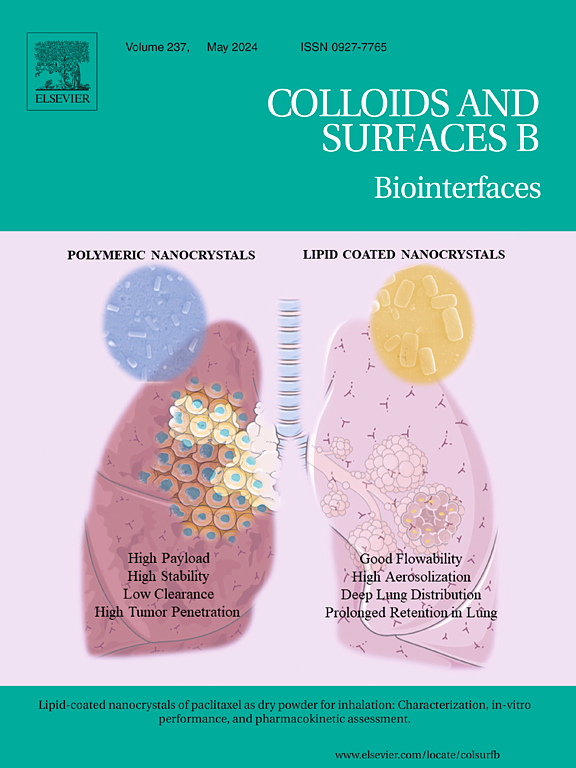贝伐单抗靶向多孔酪蛋白涂层钴铁氧体纳米颗粒:舒尼替尼递送,VEGF捕获和MRI的有效治疗剂
IF 5.4
2区 医学
Q1 BIOPHYSICS
引用次数: 0
摘要
报道了用简单的一锅水热法合成酪蛋白包被的钴铁氧体纳米颗粒(CACoFe NPs)及其作为癌症治疗剂的潜在应用。胶体和单分散的CACoFe NPs的平均水动力尺寸为245.4 nm, zeta电位为- 54.9 mV,多分散性指数(PDI)为0.282。这些半球形和晶状纳米粒子的饱和磁化强度为46.54 emu g−1,具有比表面积为118.8 m2 g−1和总孔容为0.3 cm3 g−1的多孔结构。CACoFe NPs作为靶向递送舒尼替尼的纳米载体,其载药量高达162 µg mg−1,在48 h内累积释放量为56.44 %。MTT试验显示,在暴露于200 μg mL−1 CACoFe NPs 24 h后,MDA-MB-231癌细胞的死亡率仅为12.3 %,而在相同条件下,使用贝vacizumab功能化的CACoFe NPs (B-CACoFe NPs)和苏尼替尼负载的B-CACoFe NPs (S-B-CACoFe NPs)分别获得59.9 %和68.5 %的细胞死亡率。通过实时荧光定量PCR、流式细胞术和酶联免疫吸附试验证实S-B-CACoFe NPs的主要抗癌机制为细胞凋亡。绒毛膜-尿囊膜(CAM)实验显示S-B-CACoFe NPs具有显著的抗血管生成作用。此外,B-CACoFe NPs在原位和体内诱捕血管内皮生长因子(VEGF)的能力得到验证,其诱捕效率分别为76.5 %和68.3% %。此外,CACoFe NPs具有81.6 mM−1 S−1的高R2弛豫值,并成功地用作荷瘤小鼠的磁共振成像(MRI)造影剂。本文章由计算机程序翻译,如有差异,请以英文原文为准。
Bevacizumab-targeted porous casein-coated cobalt ferrite nanoparticles: A potent theranostic agent for sunitinib delivery, VEGF trapping, and MRI
Synthesis of casein-coated cobalt ferrite nanoparticles (CACoFe NPs) using a simple one-pot hydrothermal method and their potential application as a cancer theranostic agent is reported. The colloidal and monodispersed CACoFe NPs represented an average hydrodynamic size of 245.4 nm, a zeta potential of −54.9 mV and a polydispersity index (PDI) of 0.282. These semi-spherical and crystalline NPs displayed a saturation magnetization of 46.54 emu g−1 and a porous structure with a specific surface area of 118.8 m2 g−1 and total pore volume of 0.3 cm3 g−1. CACoFe NPs served as a nanocarrier for targeted delivery of sunitinib, achieving a high loading capacity of 162 µg mg−1 and cumulative release of 56.44 % over 48 h. MTT assay showed only 12.3 % mortality of MDA-MB-231 cancer cells after 24 h exposure with 200 μg mL−1 CACoFe NPs while 59.9 % and 68.5 % cell death were obtained at the same condition using the bevacizumab functionalized CACoFe NPs (B-CACoFe NPs) and the sunitinib loaded B-CACoFe NPs (S-B-CACoFe NPs), respectively. Apoptosis was confirmed as the primary anticancer mechanism of S-B-CACoFe NPs through real-time PCR, flow cytometry and ELISA studies. The chorioallantoic membrane (CAM) assay demonstrated significant anti-angiogenic effect of S-B-CACoFe NPs. Furthermore, the ability of B-CACoFe NPs to entrap vascular endothelial growth factor (VEGF) was validated in situ and in vivo with entrapment efficiency of 76.5 % and 68.3 %, respectively. Additionally, CACoFe NPs exhibited a high R2 relaxivity value of 81.6 mM−1 S−1 and were successfully used as a contrast agent for magnetic resonance imaging (MRI) of tumor-bearing mice.
求助全文
通过发布文献求助,成功后即可免费获取论文全文。
去求助
来源期刊

Colloids and Surfaces B: Biointerfaces
生物-材料科学:生物材料
CiteScore
11.10
自引率
3.40%
发文量
730
审稿时长
42 days
期刊介绍:
Colloids and Surfaces B: Biointerfaces is an international journal devoted to fundamental and applied research on colloid and interfacial phenomena in relation to systems of biological origin, having particular relevance to the medical, pharmaceutical, biotechnological, food and cosmetic fields.
Submissions that: (1) deal solely with biological phenomena and do not describe the physico-chemical or colloid-chemical background and/or mechanism of the phenomena, and (2) deal solely with colloid/interfacial phenomena and do not have appropriate biological content or relevance, are outside the scope of the journal and will not be considered for publication.
The journal publishes regular research papers, reviews, short communications and invited perspective articles, called BioInterface Perspectives. The BioInterface Perspective provide researchers the opportunity to review their own work, as well as provide insight into the work of others that inspired and influenced the author. Regular articles should have a maximum total length of 6,000 words. In addition, a (combined) maximum of 8 normal-sized figures and/or tables is allowed (so for instance 3 tables and 5 figures). For multiple-panel figures each set of two panels equates to one figure. Short communications should not exceed half of the above. It is required to give on the article cover page a short statistical summary of the article listing the total number of words and tables/figures.
 求助内容:
求助内容: 应助结果提醒方式:
应助结果提醒方式:


